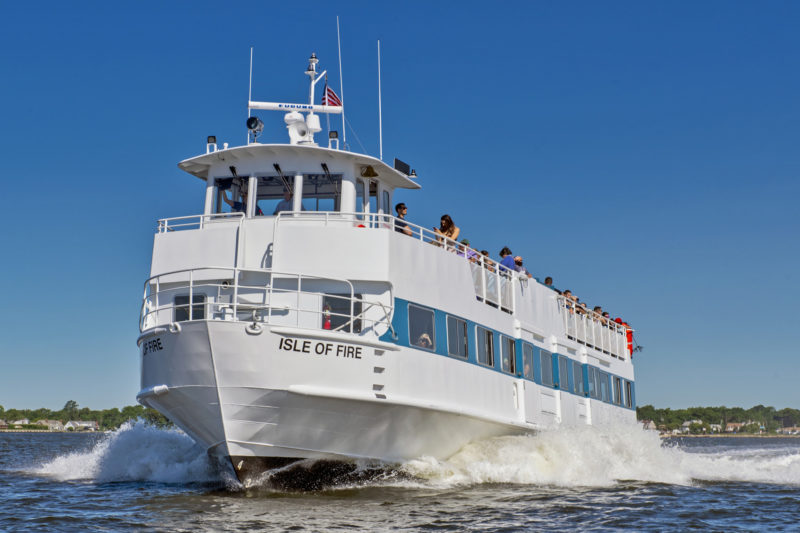The last few months have been tough for passenger vessel operators shut down by the coronavirus pandemic. The months ahead could be even tougher as they tackle reopening under new rules that challenge their creativity and viability.
They must reduce capacity, meet social distancing mandates, protect passengers and crew and rev up sanitation procedures while meeting operating costs this year, next year and beyond.
These were just a few of the items discussed by passenger vessel operators during the WorkBoat webinar Covid-19 and the U.S. Passenger Vessel Industry: Impacts and Steps to Reopen held last week.
“Our members are truly trying to figure out how to stop hemorrhaging resources and trying to figure out how to chart a course to survival into the future,” said Colleen Stephens, head of Stan Stephens Glacier and Wildlife Cruises, Valdez, Alaska, and president of the Passenger Vessel Association (PVA), which has developed guidelines for reopening.
Stephens has delayed her season until July 1 and is “literally assessing whether that’s going to be a reality.” Does a third to half of capacity pay for daily fuel or other costs? “Every operator’s going to have a different equation on that,” Stephens said during the webinar that brought together all segments of this once booming market that’s facing economic damage in the billions. “Unfortunately, there’s not a set answer.”
The Paycheck Protection Program (PPP) has helped operators retain employees but needs to be extended especially for seasonal businesses, companies say. Different jurisdictions have different rules for getting underway. Ferries that kept running saw ridership plunge. And U.S.-flag overnight operators fought to distinguish themselves from the mammoth foreign-flag cruise ships at the center of a bad publicity storm.
“We’re keeping our fingers crossed that sometime in July we’re going to be able to maybe get a few sailings underway and get a little cash flow coming in,” said Dan Blanchard, owner and CEO of UnCruise Adventures, Seattle, who organized the U.S. Overnight Passenger Small-Boat Operators Coalition.
So how do they cope? “To say you adapt quickly is probably the only way to answer,” Stephens said. “You rely on the corps that helped build you – your employees, your team, your co-workers. You look internally, look to your partners, learn from others.”
PVA’s recommendations are useful in meeting government demands. “We’re hopeful that the guidance we produced will show them that as operators we know what we’re doing,” said Bob Bijur, Island Queen Cruises, Biscayne Lady Yacht Charters, Miami.
They’re “trying to come up with a realistic way to have a product that’s attractive to the general public,” he said. “We were fortunate that a lot of our bookings were pushed back.” Still, huge challenges remain. “How do you have a wedding onboard with 200 people? We don’t have an answer right now.”
Businesses now opening have a lot more information than those that had to keep running, said Jim Swindler, deputy general manager, Golden Gate Ferry, Golden Gate Bridge, Highway and Transportation District, Larkspur, Calif. “We had to learn as we went along.”
Dave Anderson, general manager, Fire Island Ferries, Bay Shore, N.Y., which operates year-round, has this advice for those starting back: Make sure that you have a plan, not just to reopen but moving forward. And be prepared to add a vessel if one is getting too crowded.
“This has been one of the most challenging things that myself and everybody here has ever been through,” he said, ticking off past disasters like hurricanes and 9/11. “Right now, we don’t know what’s going to happen from day to day. We don’t know what’s going to happen from hour to hour. We don’t know what’s going to happen from trip to trip. Just make sure you’re ready for it and you can accommodate any demand that comes your way.”
Rob McMahon, president, Pinnacle Marine Corp., La Crosse, Wis., the largest broker of passenger vessels and businesses in North America, said that early on “I felt like the Maytag repairman….People weren’t calling.” They had showings cancel and minimal contacts.
Things have started to come back and they’ve had a sale closing or two. Plus, “we actually sold a vessel to a start-up operator,” he said.
Overnight lines have to contend with a no-sail order from the Centers for Disease Control and Prevention (CDC) that extends into July for vessels with passenger and crew totals of 250 or more. Most of Blanchard’s coalition members are well under the limit.
“It’s a two-edged sword, because even though we can legally operate, will the market be there? The answer is initially, ‘no.’ We don’t believe the market’s really going to return here until sometime in July.”
Others in his coalition are plotting their course back as well.
American Cruise Lines (ACL) plans to begin cruising June 20 with the American Song on the Columbia and Snake rivers and June 28 with the American Harmony on the Mississippi River, a spokesman said. They also are considering a late June or July start on the American Constellation in Alaska. Vessels, which are under CDC’s 250 limit, are sailing at 75% capacity.
American Queen Steamboat Co. (AQSC) expects to resume operating the American Empress on the Columbia and Snake rivers July 6 and the American Duchess on the Mississippi River July 20. Dates for the American Queen and the new American Countess have not been announced. The new timeline is in response to the evolving nature of the pandemic and “continued widespread governmental restrictions across ports, cities and public institutions,” the company said.
AQSC’s Victory Cruise Lines said it has cancelled trips for the rest of the 2020 season “due to prolonged governmental restrictions and uncertainties of future travel through Canadian waters.”
Both cruise lines have beefed up health and sanitation regimes.
AQSC has contracted with Ochsner Health to assess the American Queen, American Duchess and American Countess and work with the operator on disease prevention and mitigation strategies on its fleet. The program includes real-time access to infectious disease experts in Ochsner’s system, which serves Louisiana, Mississippi and the Gulf South. The company expects to announce soon a healthcare partner for its Pacific Northwest itineraries on the American Empress.
Ochsner will reassess the vessels on a monthly basis, AQSC said, and its personnel will oversee pre-boarding screenings and assessments on all itineraries embarking in New Orleans. AQSC will identity healthcare partners for its other ports.
AQSC’s new health and safety procedures include crew screenings, increased sanitation measures and onboard tele-health capability. Onboard measures also include hourly cleaning of surfaces such as handrails, door handles and elevator controls with an all-chlorine solution, and disinfecting wipes in staterooms, AQSC said.
ACL partnered with Vikand Solutions, a maritime medical management firm, and will have nurses or EMTs on board. ACL also points out it has independent HVAC systems with no shared duct work in cabins and lounges.
Other onboard practices include PPE for all housekeepers, hourly sanitation of touchpoints such as railings, doorknobs, elevator buttons and gangways, and disposable covers on each TV remote control prior to passenger boarding. Main dining room capacity will be reduced and tables will be used only once during each meal.
Passengers and crew will be screened before boarding and crew will be screened at the end of each cruise. ACL will have a “medical tent with pre-boarding screening including respirations, oxygen, and temperature check. Covid-19 testing will be performed as needed.” Luggage will be sanitized before loading.





